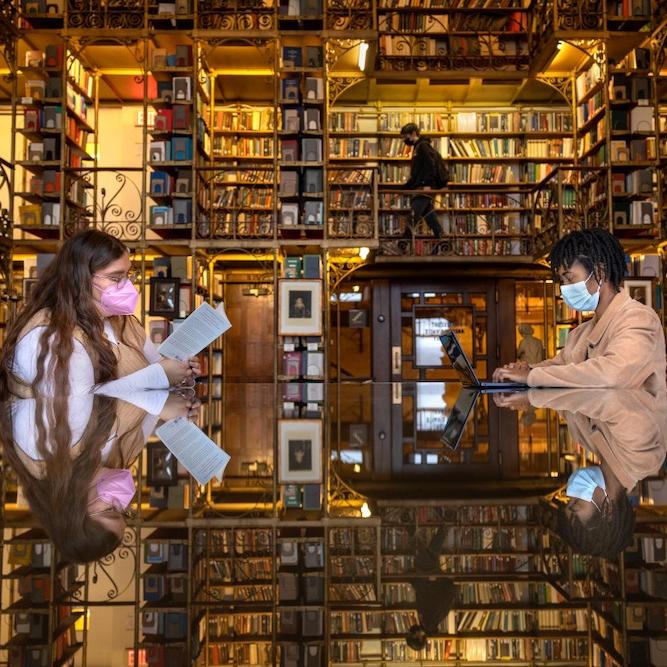Kevin Cruz ’18 describes the underpinnings of his passion for art as an “accumulation of coincidences.” Living in an over-saturated school district in Los Angeles, California, Cruz was given the chance to transfer to a high school, in an adjacent district, focused on art. Once there, he immersed himself in the Los Angeles graffiti scene and eventually started perceiving art as a language through which he could simultaneously explore his identity as well as shape it.
Issues of identity have always fascinated Cruz; in fact, he chose Cornell over stand-alone art schools due to the opportunities he felt he’d have to take courses in political studies outside of the core art curriculum. “I don’t see myself as somebody who can find inspiration by ruminating alone in my studio; I find myself constantly influenced by events around me and have a keen interest in the confluence of politics and art. Cornell was a great option, in that it allowed me to engage with a variety of my passions.”
How an Artist’s Works Reflect Political Calamities
One of Cruz’s initial works at Cornell, Ni Uno Mas (Not One More), explores the migrant child crisis along the United States-Mexico border where unaccompanied minors would often cross illegally to the United States, often meeting with a tragic death or sexual exploitation. The composition depicts a fence under a crimson sky, accentuating both the bleakness of the border region as well as the motif of violence associated with the crisis. A tombstone in the foreground is etched with the work’s titular words, accompanied by several graves on both sides of the fence. “When we discuss immigration,” Cruz says, “we often solely focus on the people who’re in the United States. We forget, sometimes, that some didn’t even make it past the border. They lost their lives, often in tragic circumstances.”
Indeed, politics is a common trope across Cruz’s body of work; he has frequently sought inspiration from personal experiences and projected them on a societal level through his art. In La Muerte Del Campesino (Death of the Farmer), Cruz explores the historical events leading up to his parents’ migration to the United States. “The conflicts in El Salvador in the 1970s were terrible for rural areas, and farming stopped being a sustainable income source for many in the countryside, including my grandfather. I began to explore this chain of events; if the violence hadn’t occurred, my parents would never have settled down in Los Angeles, and I may have been a completely different person today.” This motif of immigration is further explored in Que me ves quey (What are You Looking At?), a series of stark photographs that explore the way immigrants are perceived in America. Like his previous works, Cruz found inspiration for this series from his personal experiences as well as from the characterization of immigrants as aliens, a term he finds both slightly amusing and disparaging.
An Expanding Personal, Academic, and Aesthetic Experience
Although Cruz admits that he found adjusting to life at Cornell to be a slightly challenging process, he mentions a particular course for having helped him ease into the transition from life in bustling Los Angeles to a more contemplative experience in Ithaca. “I mistakenly took a senior-level course taught by Professor Ella Diaz [Latina/o Studies] during my freshman year, but it turned out to be a great decision. Aside from the academic aspect, the course gave me the chance to re-connect with my community and elements of my life from back home in Los Angeles.” Cruz also says that the course led him to develop a deeper level of engagement with the Chicano Art Movement as well as with several artists who have influenced his work, including Rupert Garcia and Yolanda Lopez.
Garcia’s work, in particular, has left a substantial imprint on Cruz. He credits a recent series of compositions depicting iconic Americans, including Malcolm X and Harriet Tubman, to Garcia’s pop art compositions. The works, at 4 feet by 12 feet, are easily Cruz’s largest compositions, and their size represents his intention to commemorate these larger-than-life personalities. One of the compositions, Encuentro 5, is now permanently installed at the Tompkins County Workers’ Center in downtown Ithaca.
“These tragedies are driving my next work—portraits of people whom I have lost. Through my compositions, I plan to create a space where the audience, too, can mourn the people they’ve lost.”
Commemoration has recently emerged as a significant motif in Cruz’s work. “A close friend back home passed away, as did a friend in the Latino Living Center at Cornell. These tragedies are driving my next work—portraits of people whom I have lost. Through my compositions, I plan to create a space where the audience, too, can mourn the people they’ve lost.”
Delving Deeper into Culture and Art
Although Cruz now feels comfortable using several mediums, he initially preferred silk screening, a process where the artist inks a surface and prints the created impression on to paper. “Silk screening isn’t specifically taught at Cornell, and I never exactly learned it in high school either. It’s actually a commercially driven process. It allows you to quickly make up to hundreds of prints of the same image. It began as a personal hobby, and I’ve found that its characteristics complement my pop art compositions well.”
Learning at Cornell has allowed Cruz to acquire an advanced language through which he can engage with works on a deeper level. “The terminology as well as different points of view that I’ve picked up here mean that I can better understand compositions, in terms of both the aesthetic experience as well as the meaning conveyed by the work.”
After completing his undergraduate degree in spring 2018, Cruz plans to pursue a doctorate in American and Chicana/o studies. The subject, he says, combines his interest in art and politics with his overarching desire to delve deeper into his culture.
Photo credit: Beatrice Jin, Dave Burbank






